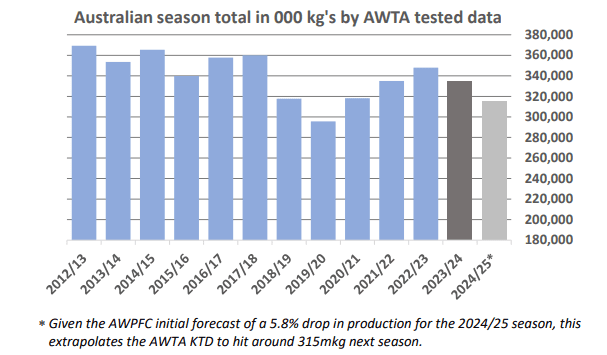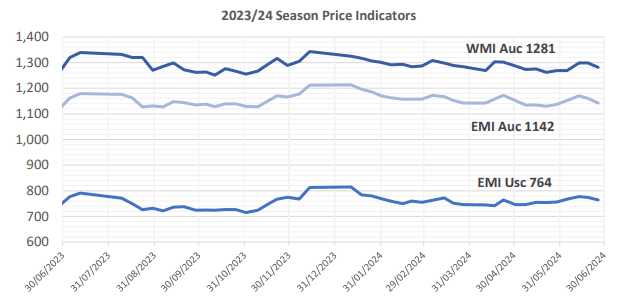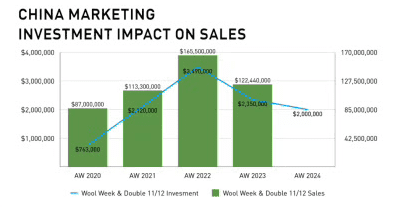
AWI chairman Jock Laurie.
AUSTRALIA’S international wool customers are being told current wool prices are unsustainable for growers, as the industry’s marketing research and development body fights for a bigger levy handout from growers.
At the Australian Sheep and Wool Show in Bendigo this week, Australian Wool Innovation chairman Jock Laurie said AWI’s chief executive officer John Roberts spent a month overseas recently telling European stakeholders that the current price of wool in Australia is not sustainable.
“That the industry is hurting and that they need to be aware of that … don’t come to us in two years’ time and wonder where the wool is, because it’s driving change now.
“He then went Japan and Korea with the exactly the same message and then we’ve had Chinese come out there that we’ve given the same message too,” he said.
“And he is going to China on Thursday to spend the week up there to give the same message.”
“The reason for that is that, interestingly enough, is when the big change (in wool production) happened after the Reserve Price Scheme, a lot of groups were saying ‘well, where is all the wool?’ Mr Laurie said.
“Well, growers couldn’t go broke, growers have got to make money too and so it changes.
“What we are seeing right now, I mean the wool forecasting committee (forecast) has gone from 328 million kgs down to about 305m or 306m or something, that’s where it’s going in the next 12 months,” he said.
“And what the West Australians around here will tell you is that they are fearful it might be more than that.”


Keeping wool ‘front of mind’ – Laurie
Mr Laurie told Sheep Central that with its constrained budget, the company was being more strategic in what it did, focusing on areas of critical importance to the industry.
Shearing is a priority on different levels, from training, to shed design, to bioharvesting.
As far as marketing is concerned, what is important included defending the industry’s right to grow and market wool, and understand legislation being introduced globally and its impact on wool. This included the PEF work.
He said the industry had also done an enormous amount of work in reducing methane on a production per kilogram basis, but never promoted or shown that.
“So we’ve got to get all that methodology right.”
He said the “Wear wool not fossil fuel’ campaign was about engaging the community to understand that synthetic fibres are being produced from fossil fuels.
Mr Laurie said in the current “flat market” AWI’s marketing campaigns aimed to ensure that when consumers’ resume spending that wool is “front of mind”.
“So the marketing is about positioning wool in the front of the minds of people who have money, affluence, to be able to go and buy, and think about buying wool.
Mr Laurie said if AWI is “not in that space” it is “behind the eight ball” when consumers start spending money.
“So, our thinking is, invest the money, keep wool at the forefront as much as we possibly can, so that we are positing ourselves for any spike.
“Obviously when you do get a spike and the market moves our marketing teams may come to us and say ‘righto, we need to take advantage of this opportunity her or that opportunity there’, because we know in a rising market that investment in marketing equates to the sale of wool and when we reduce marketing we see a drop off in the sales of wool.”
 Mr Laurie said this is what the China spend/sale graph from AWI/Woolmark’s general manager marketing and communications Laura Armstrong Armstrong had shown during Wool Week.
Mr Laurie said this is what the China spend/sale graph from AWI/Woolmark’s general manager marketing and communications Laura Armstrong Armstrong had shown during Wool Week.
“That means that in a flat market like we’ve got now if we keep talking about wool, we know we get a response.”
However, Mr Laurie said AWI did not have sufficient influence to halt the fall in the Australian wool price benchmark, the AWEX Eastern Market Indicator.
He said AWI’s marketing spend on wool could not compare to that spent by the synthetic fibres internationally.
“To be able to get the response in the marketplace because of the natural and environmental attributes of the fibre is pretty staggering, but it’s pretty hard to explain that to somebody when the EMI has slipped to 1103 cents after a shocking week or two.”
Mr Laurie said in simple terms, AWI believed its efforts to defend wool and keep it at the forefront with customers would mean sales when the market turned around.

The country was built on the Merino’s back. Why kill this industry? It doesn’t make sense, when the world needs natural product.
I think the Aussie sheep farmer produces a wonderful natural product that probably has never been marketed right from the 80s. Perhaps if we could have modern wool mills that were automated to produce a value-added product to sell to the world it would help. Lately there has been government inference such as the live sheep export trade ban, which at the moment affects WA, but will in turn affect the east when the supply of Merino ewes stops coming east after a drought. And there are the heritage laws, not to mention the divide between city and country that keeps growing by the year. I think farmers can handle climate situations, after all they’ve been doing that since 1788. You would think the world would embrace a renewable resource in the current political climate. I’m not sure what the answer is.
Wool and sheep meat will become cottage industries if governments do not act now.
Boycott all Australian wool that originates from farms that still use mulesing and tail removal without anaesthetic, speed shearing and until live export ends. Sheep are treated abominably in most places in Australia. Find out where your wool is from and speak up against abjectly cruel and outdated treatment of these gentle creatures. Support ethical farmers.
In my 50 years of being in the wool industry I have never seen a better time to sell wool than in the last five years. All the clean, green environmental facts are there. So why aren’t the wool buyers fighting over the wool in the auction room?
It comes down to the marketing of our great product. Woolmark has, in my opinion, failed to push our product to the middle class. They have concentrated as usual on the high end market to the detriment of making wool clothing an everyday item. My wife commented that we should be able to buy woolen garments at stores like K Mart and Target all year around, and at similar stores in North America and all through Europe.
I believe that Woolmark should be cut and the marketing of wool put in the hands of outside, professional marketing companies on an incentive basis. The wool levy would be used to fund this.
To have AWI asking for a raise in the levy is rubbing salt into the wound. ” Give me more so we can do the same” is not going to work.
Wool growers would be happy to pay a higher levy if we thought that the indicator could be kept at a sustainable, profitable level through better marketing.
Kim Cartwright
Wool grower, classer, shearer, wool tester, Merino breeder, stud breeder, 50 years in the industry.
Kim, you certainly raise some interesting views which I personally know a lot of wool growers would agree with. Re this article: I maybe mistaken although I’ve possibly never seen a synthetic fibre company promote a product. I’ve seen influencers support brands that use synthetic materials. Maybe the difference is that and I’d like to believe the marketing personnel at AWI do relate to that.